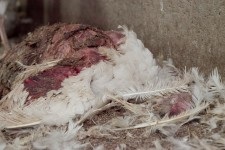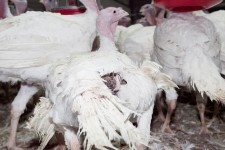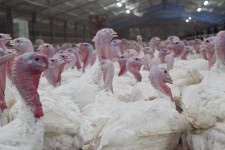- Overview
- Confinement
- Turkey poults
- Mutilation
- Artificial lighting
- Health Concerns
- Use of antibiotics
- Genetic alterations
- Muscle disorders
- Skeletal disorders
- Lame and injured birds
- Mortality rate
- Artificial insemination
- Health problems of breeders
- Slaughterhouse
- Turkeys: sentient and intelligent
- Conclusion
- References
Skeletal Disorders
Due to factory-farmed turkeys' rapid growth rate and distorted muscle development a variety of leg problems develop which produce lameness and pain. The increase of breast muscle on a turkey leads to a physiological weight imbalance that increases stress on bones and joints.(53) Due to the weight imbalance the leg position of the turkey changes. Skeletal problems such as antitrochanteric degeneration, tibial dyschondroplasia, bending, twisting and rotation of the tibia, osteochondrosis, osteomyelitis, rickets and epiphyseolysis of the femoral head are increased.(54)
Inspections by animal advocates across Australia continue to show that a considerable number of factory-farmed turkeys suffer from skeletal leg disorders. Turkeys with skeletal disorders will often spend a substantial amount of time lying down, having collapsed after taking only a few steps. (See Figure 9).

 Figure 9: Two rescued factory farmed turkeys in Australia approximately 10-weeks-old who have leg injuries and distorted bones and find it difficult to stand and support their overweight bodies.
Figure 9: Two rescued factory farmed turkeys in Australia approximately 10-weeks-old who have leg injuries and distorted bones and find it difficult to stand and support their overweight bodies.



